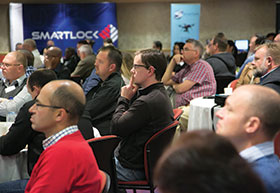

The South African chapter of the Transport Asset Protection Association (TAPA) held its annual conference in Johannesburg earlier this year. The well-attended event covered a host of issues relating to the security of goods and people in the logistics industry, both on the road as well as issues pertaining to the warehousing of goods.

The conference was facilitated by Massimo Carelle, MD of KMR Group & Associates, who started the day off with a welcome and kept proceedings running smoothly. Andre Du Venage, the chairman of TAPA SA also welcomed guests and set the scene for the day before the first presenter was introduced.
An introduction to TAPA EMEA

Laurence Brown, a TAPA EMEA director was first up with a presentation that gave the audience a keener insight into the association and the dangers faced in the cargo hauling industry across EMEA.
He said TAPA’s goal is to reduce losses suffered in the supply chain through its security standards (which a later presentation focused on), as well as the provision of information pertinent to the industry. This is something all members can make use of, while also contributing data to the organisation in order to assist them in providing the most accurate information on the security situation on the ground possible.
Brown highlighted the numerous threats to the supply chain and the associated threats to business and the economy in general. A study by the European Parliament found that the true cost of a loss can be between five to seven times the value of the goods stolen.
Looking at the numbers from TAPA’s Incident Information Service (IIS) in the EMEA region (including data from South Africa), Brown found there was an 11% increase in cargo crime across the region in 2017 as compared to 2016. Contrary to many in the audience’s expectations, the largest heist of the year happened in the UK where a cash-in-transit (CIT) heist netted the thieves over 8 million euros. The UK also clinched the number two spot with a cargo heist of almost 6 million euros, while South Africa came third with a hijacking targeting high-value goods worth almost 3.5 million euros.
TAPA uses these incidents as learning experiences and tries to prevent future ones by working with a range of law enforcement organisations and other stakeholders to promote security across the supply chain.
The value of systems to ensure business success

A logistics business is still a business, although it may have a few unique challenges. Business coach Stefan Van Rooyen was up next with a presentation giving advice to the delegates on how to ensure they are able to implement the right systems and processes to ensure business success. He warned that burnout is the greatest cause of failure, which is why systems and processes are critical to ensure you get more done, but with fewer resources (which includes the business owner’s time and effort).
Van Rooyen explained that the manner in which one gets more for less is by the careful implementation of:
- People & education,
- Systems & technology,
- Delivery & distribution, and
- Testing & measuring.
Moving on from the above, he also stated that the way to get the most from your team without stressing anyone into a burnout phase was by
1. Strong leadership,
2. A common goal,
3. A clear understanding of the rules of the game,
4. Developing and implementing an action plan,
5. Supporting risk taking, and
6. 100% involvement/inclusion.
Among the steps involved in accomplishing these steps is ensuring everyone and every department takes responsibility and accountability for their goals. This means making sure each position in the company has been assigned key performance indicators (KPI) by which people are measured, and the same applies to departments and the company as a whole.
And finally, tracking your time is an excellent way to determine what you spend most of your time on, which allows you to understand what changes should be made to allow the right people to spend the right amount of time on the right tasks.
The failure of technology

The next presentation addressed the issue of why crime is at an all-time high when there is so much advanced technology available to individuals and businesses. Alwinco’s Andre Mundell was tasked with highlighting what is missing.
Of the many issues Mundell’s presentation covered, he highlighted that businesses often fail in doing a proper security risk assessment that will highlight what their vulnerabilities are and point them down the path to being able to mitigate those risks. He stressed that
a proper assessment is not a product assessment or even the same as a health and safety assessment where the likelihood of something happening is determined (or guessed).
A security risk assessment breaks the link between desire, ability and opportunity. Criminals have the desire and it’s easy to learn the abilities required to commit whatever crime they fancy, so the risk assessment needs to remove the opportunity, or at least make it so difficult to take advantage of that they look for easier pickings. As Mundell explained, “Opportunity makes the thief.”
He highlighted the four elements that are part of every crime in some way or another:
1. Victims have a poor level of knowledge or none at all of the best means to secure their asset.
2. Victims are not in control of their security before or after the crime occurs.
3. Victims seldom have security plans for the future.
4. Victims have never had a proper security risk assessment conducted.
The key to beating the criminals is control. Each individual or business needs to have control over its own environment to allow it to proactively prepare for and deter the criminal intent. And if or when something happens, the response must be prepared and ready to roll out immediately. In addition, he noted that the most dangerous phrase in security is: “We have always done it this way”.
Mundell ended by noting: “For any crime, it is not an event that occurs randomly, but is the final stage of a planning process on the criminal’s behalf.”
Intelligence-driven risk management
One of the elements to consider when focusing on mitigating risk is that of obtaining the right information to assist you in your planning. As mentioned by Brown and Mundell, you need accurate information to assist you in making the right decisions.

The next presentation was all about information, collecting and analysing it, and how to best make use of it. It was presented by Arnold van den Bout from Online Intelligence in a presentation entitled The Value of Intelligence in Risk Management.
As an example, Van Den Bout noted that cargo crimes and hijackings are nothing new. The earliest record we have of these crimes comes from the late 1600s when disbanded soldiers attacked coaches (stagecoaches and even postal carriers) because they were easy (unprotected) targets. The same concept happens today where organised and well trained people attack cargo carriers because they are easy targets. (The link to military or police training is a popular one, but is seldom proved in court.) In South Africa, their actions can also be disguised as protests, as we saw in April where 40 trucks were destroyed and over R250 million was lost in one location in less than one month in KwaZulu-Natal.
The nature of risk, he explained is fluid and it changes over time as circumstances change, making it hard to always be on top of things. This is where crime intelligence plays a role. Crime intelligence analysis, according to Van Den Bout, “is the systematic analytical study of crime and intelligence, where cognitive methods are applied to weigh and test information, in an attempt to arrive at a characterised known, and a forecasted future”.
By analysing information from a variety of sources, one will be able to use historic data as well as current information and environmental triggers to more accurately predict and plan for attacks and realise vulnerabilities. Effective intelligence allows one to adjust to changing circumstances and deploy the relevant risk controls, more accurately predict criminal behaviour, and increase prosecutions and successful convictions, while disrupting the criminal enterprise.
The key, Van Den Bout said, is to make better use of intelligence in prevention, containment and reaction planning and processes.
Why is CIT such a successful target?

Author, Anneliese Burgess was up next with a presentation on the research she did for her book ‘Heist! South Africa’s cash-in-transit epidemic uncovered.’ CIT heists are nothing new in South Africa, in fact, at one stage the numbers were on the decline. However, the presentation started by noting that in 2014 there were 180 CIT incidents, which jumped to 378 in 2017 – that’s more than one per day. This is of such concern that even international TV stations are reporting on it.
Furthermore, despite a massive police focus on this area, this is still a daily occurrence, with 183 on the books for 2018 at the time of the conference (July, 2018). ‘Heist!’ only focused on a few of these crimes, but the research done provides keen insights into this lucrative criminal career.
In a nutshell, these crimes are well planned and executed, a lot of money goes into the planning, including surveillance, grooming and recruiting people inside CIT companies as well as police officers. And, unsurprisingly, there is no limit to the amount of violence they are prepared to use.
Strangely enough, these criminals see themselves as professionals and the few that are jailed plan to return to crime once released – prison rehabilitation is of no use. Perhaps this is because CIT operatives are seen as the cream of the crop and it takes a long time for someone to ‘be promoted’ this level in syndicates. As such, the criminal justice system is not feared and even being out on bail will not put a dampener on their plans. In the words of one criminal interviewed: “It’s easy, it’s lucrative, it’s low risk…”
After enlightening the attendees with more insights and unpleasant facts, Burgess ended by saying: “The problem is far bigger than CIT (and even that is bigger than we think)”.
How TAPA helps

Paul Linders, TAPA EMEA board member and standards lead drew the attention back to the organisation by talking about what the association does to assist its members and help protect people and goods in the supply chain. Firstly, there are the TAPA standards that assist member companies in implementing best practices when securing their facilities and goods in transit.
The Facility Security Requirements (FSR) standards deal with how products are handled in facilities (like warehouses), while the Trucking Security Requirements (TSR) offers standard of dealing with goods as they are transported by road. To date, Linders said there have been over 1 500 companies certified globally according to TAPA standards, sadly only 19 of those are in South Africa.
The TSR is complemented by the new PSR (Parking Security Requirements) standards to assist transporters in identifying secure parking facilities for trucks while on the road. This is supported by TAPA’s Secure Parking tool which helps truckers in Europe find safe places to park during the night or for rest stops. The same could be implemented for South Africa, but the association needs input from companies in the business to assist in identifying secure locations – or to highlight areas where there are known dangers.
The same applies to TAPA’s Incident Information Service (IIS), a service that collates crime intelligence and loss data. The service is available to South African members as well, but as opposed to the EU where 2880 incidents were reported in 2017 (685 in Q1 2018), South Africa saw only 53 incidents reported in 2017 and 20 in Q1 2018. Linders says the industry in South Africa must play a greater role in making information available, which will assist each member in making safer decisions regarding their role in the supply chain.
To find out more about certification or being part of the IIS, contact info@tapaemea.org, or go to www.tapaemea.org.
Extracting value from security technology
Hi-Tech Security Solutions’ editor was up next with a presentation on how to extract the maximum value from your security technology by changing the way one approaches security. Instead of a margin game where the cheapest quote gets the deal, we need to develop smarter strategies that lead to smarter solutions making full use of the ‘smarter’ technology available today.
At the same time we need to take cognisance of the convergence of technologies between previously independent fields (such as IT and physical security, as one example) and make use of the benefits this convergence offers. The result is a solution with a longer lifespan, a lower cost of ownership over that lifespan, and real, measurable results that add value to your company while ensuring safety and security in the process.
Case study on truck hijacking
TAPA SA’s chairman, Andre Du Venage ended the day with a presentation on truck hijackings, with a focus on one specific incident from 2016. Du Venage set the scene with insights into the environment hauliers operate in and the risks and challenges they face on a daily basis. Following this, he went into detail on the hijacking that occurred and how the incident played out with the cargo vehicle itself as well as the support the company had looking out for the cargo.
Even with the care taken to ensure the success of the delivery, Du Venage showed that in the security field one should always be prepared for the unexpected. This includes being aware that syndicates can easily (or so it seems) gain information from inside companies which they then use in planning and carrying out their criminal operations. It’s not only the guys with guns you need to include in your scenario planning, it’s also those who choose to cooperate with syndicates, or are forced
into collusion.
The conference was supported by a number of sponsors, each of which is mentioned in the subsequent article. Feedback from the attendees on the day showed that the conference was a good opportunity to gain insight on the latest issues facing the logistics industry, as well as a good occasion to network with industry peers.
| Tel: | +27 11 543 5800 |
| Email: | malckey@technews.co.za |
| www: | www.technews.co.za |
| Articles: | More information and articles about Technews Publishing |
© Technews Publishing (Pty) Ltd. | All Rights Reserved.